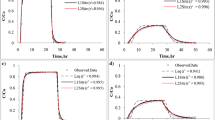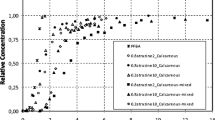Abstract
When the non-aqueous phase liquid (NAPL) contaminant is entrapped in soil pores, their release to the subsurface environment is mainly limited by interphase mass transfer such as dissolution and sorption. Sorption onto the aquifer material plays an important role as a retardation mechanism in subsurface contaminant transport processes. Considering the heterogeneity associated with aquifer properties as well as contaminant source distribution, long-term contamination is an inevitable consequence of mass transfer limitation of residual mass from soil micropores. A comprehensive numerical model is presented in this study for understanding the kinetic nature of dissolution and sorption of hydrophobic hydrocarbons and their interactions in order to estimate the rate and extent of mass removal from different phases. The results showed that sorption by soils and sediments having different physicochemical properties generally follow non-linear behavior. It is observed from the study that sorption non-linearity can be effectively incorporated by the two-site kinetic model rather than combination of linear and non-linear sorption isotherms. Even though initial phase of mass transfer is dissolution-dominated, the extended tailing of concentration at higher pore volumes is controlled by non-equilibrium sorption, which is better explained by the two-site kinetic model.












Similar content being viewed by others
References
Abderahim G, Mohammed M (2011) The use of a mixed scheme: mixed hybrid finite elements method/finite volumes (MHFE/FV), for the modeling of contaminants transport in unsaturated porous mediums. Arab J Geosci 4:669–680. doi:10.1007/s12517-010-0245-8
Agah A, Ardejani FD, Ghoreishi H (2013) Two-dimensional numerical finite volume modeling of processes controlling distribution and natural attenuation of BTX in the saturated zone of a simulated semi-confined aquifer. Arab J Geosci 6:1933–1944. doi:10.1007/s12517-011-0467-4
Al Othman ZA, Habila MA, Hashem A (2013) Removal of zinc (II) from aqueous solutions using modified agricultural wastes: kinetics and equilibrium studies. Arab J Geosci 6:4245–4255. doi:10.1007/s12517-012-0672-9
Allen-King RM, Grathwohl P, Ball WP (2002) New modeling paradigms for the sorption of hydrophobic organic chemicals to heterogeneous carbonaceous matter in soils, sediments and rocks. Adv Water Resour 25:985–1016
Anderson MR, Johnson RL, Pankow JF (1992) Dissolution of dense chlorinated solvents into groundwater. 3. Modeling contaminant plumes from fingers and pools of solvent. Environ Sci Technol 26:901–908
Branuner JS, Widdowson MA (2001) Numerical simulation of a natural attenuation experiment with a petroleum hydrocarbon NAPL source. Ground Water 39:939–952
Breus IP, Mishchenko AA (2006) Sorption of organic contaminants by soils (a review). Eurasian Soil Sci 39:1271–1283
Brusseau ML, Jessup RE, Rao PSC (1991a) Non-equilibrium sorption of organic chemicals: elucidation of rate-limiting processes. Environ Sci Technol 25:134–142
Brusseau ML, Larsen T, Christensen TH (1991b) Rate-limited sorption and non-equilibrium transport of organic chemicals in low organic carbon aquifer materials. Water Resou Res 27:1137–1145
Chamkha AJ (2007) Numerical modeling of contaminant transport with spatially-dependent dispersion and non-linear chemical reaction. Nonlinear Anal Model Control 12:329–343
Chu M, Kitanidis PK, McCarty PL (2007) Dependence of lumped mass transfer coefficient on scale and reactions kinetics for biologically enhanced NAPL dissolution. Adv Water Resour 30:1618–1629
Clement TP, Sun Y, Hooker BS, Petersen JN (1998) Modeling multi-species reactive transport in groundwater. GWMR 18:79–92
Clement TP, Guatam TR, Lee KK, Truex MJ, Davis GB (2004) Modeling of DNAPL dissolution, rate-limited sorption and biodegradation reactions in groundwater systems. Bioremed J 9:47–64
Couto PRL, Malta SMC (2008) Interaction between sorption and biodegradation processes in contaminant transport. Ecol Model 214:65–73
El Alfy M (2012) Integrated geostatistics and GIS techniques for assessing groundwater contamination in Al Arish area, Sinai, Egypt. Arab J Geosci 5:197–215. doi:10.1007/s12517-010-0153-y
El Maghraby MMS (2014) Hydrogeochemical characterization of groundwater aquifer in Al-Madinah Al-Munawarah City Saudi Arabia. Arab J Geosci. doi:10.1007/s12517-014-1505-9
Essaid I E, Cozzarellib I M, Eganhouseb R P, Herkelratha W N, Bekinsa B A and Delin G N (2003) Inverse modeling of BTEX dissolution and biodegradation at the Bemidji, MN crude-oil spill site. J Conta Hydrol 67:269–299
Heyse E, Augustijn D, Rao PSC, Delfino JJ (2002) Non-aqueous phase dissolution and soil organic matter sorption in porous media: review of system similarities. Criti Rev Environ Sci Technol 32:337–397
Huang W, Young TM, Schlautman MA, Yu H, Weber WJ Jr (1997) A distributed reactivity model for sorption by soils and sediments. 9. General isotherm nonlinearity and applicability of the dual reactive domain model. Environ Sci Technol 31:1703–1710
Huang W, Peng P, Yu Z, Fu J (2003) Effects of organic matter heterogeneity on sorption and desorption of organic contaminants by soils and sediments. Appl Geochem 18:955–972
Iovino P, Canzano S, Capasso S, Di Natale M, Erto A, Lama A, Musmarra D (2013) Single and competitive adsorption of toluene and naphthalene onto activated carbon. Chem Eng Trans 32:67–72. doi:10.3303/CET1332012
Jaynes WE, Vance GE (1999) Sorption of benzene, toluene, ethylbenzene, and xylene (BTEX) compounds by hectorite clays exchanged with aromatic organic cations. Clays Clay Miner 47:358–365
Johnson GR, Zhang Z, Brusseau ML (2003) Characterizing and quantifying the impact of immiscible-liquid dissolution and nonlinear, rate-limited sorption/desorption on low-concentration elution tailing. Water Resour Res 39:1–8
Joshi N, Ojha CSP, Sharma PK (2012) A nonequilibrium model for reactive contaminant transport through fractured porous media: model development and semianalytical solution. Water Resour Res 48, W10511. doi:10.1029/2011wr011621
Khodaverdiloo H, Samadi A, Motlagh MB, Dashtaki SG, Han F (2013) Characterization of parameters of sorption isotherm models of cadmium in selected semi-arid region agricultural cambisols and calcisols. Arab J Geosci 6:3389–3395. doi:10.1007/s12517-012-0585-7
Kim S, Hwang I, Kim D, Lee S, Jury WA (2003) Effect of sorption on benzene biodegradation in sandy soil. Environ Toxic Chem 22:2306–2311
Maraqa MA, Khashan SA (2013) Modeling solute transport affected by heterogeneous sorption kinetics using single-rate nonequilibrium approaches. J Contam Hydrol. doi:10.1016/j.jconhyd.2013.11.005
Maraqa MA, Zhao X, Lee J, Allan F, Voice TC (2011) Comparison of nonideal sorption formulations in modeling the transport of phthalate esters through packed soil columns. J Contam Hydrol 125:57–69
Miller CT, Poirier-McNeill MM, Mayer AS (1990) Dissolution of trapped non-aqueous phase liquids: mass transfer characteristics. Water Resour Res 26:2783–2796
Nambi IM, Powers SE (2000) NAPL dissolution in heterogeneous systems: an experimental investigation in a simple heterogeneous system. J Conta Hydrol 44:161–184
Nambi IM, Powers SE (2003) Mass transfer correlations for non aqueous phase liquid dissolution from regions with high initial saturations. Water Resour Res 39:1–11
Natarajan N, Suresh Kumar G (2010) Radionuclide and colloid co-transport in a coupled fracture-skin-matrix system. Colloids Surf A Physicochem Eng Asp 370:49–57
Nourmoradi H, Khiadani M, Nikaeen M (2013) Multi-component adsorption of benzene, toluene, ethylbenzene and xylene from aqueous solutions by montmorillonite modified with tetradecyl trimethyl ammonium bromide. J Chem (Hindawi Publ Corp) Article ID 589354
Pan B, Ning P, Xing B (2008) Part IV: sorption of hydrophobic organic contaminants. Environ Sci Pollut Res 15:554–564
Pignatello JJ, Xing B (1995) Mechanisms of slow sorption of organic chemicals to natural particles. Environ Sci Technol 30:1–11
Powers SE, Abriola LM, Weber WJ Jr (1994) An experimental investigation of non-aqueous phase liquid dissolution in saturated subsurface systems: transient mass transfer rates. Water Resour Res 30:321–332
Prommer H, Davis GB, Barry DA, Miller CT (2002) Modeling the fate of petroleum hydrocarbons in groundwater. Proc. 5th national workshop on the assessment of site contamination. Adelaide 2002:21–45
Rahnama MB, Zamzam A (2013) Quantitative and qualitative simulation of groundwater by mathematical models in Rafsanjan aquifer using MODFLOW and MT3DMS. Arab J Geosci 6:901–912. doi:10.1007/s12517-011-0364-x
Rao GT, Rao VVSG, Surinaidu L, Mahesh J, Padalu G (2013) Application of numerical modeling for groundwater flow and contaminant transport analysis in the basaltic terrain, Bagalkot, India. Arab J Geosci 6:1819–1833. doi:10.1007/s12517-011-0461-x
Reeves WR, McDonald TJ, Cizmas L, Donnelly KC (2004) Partitioning and desorption behavior of polycyclic aromatic hydrocarbons from disparate sources. Sci Tot Environ 332:183–192
Reible DD (2005) Organoclay Laboratory Study - McCormick and Baxter. Final Report, Oregon Dept Environ Qlty Proj 005-05
Renu V, Suresh Kumar G (2012) Numerical modeling and spatial moment analysis of solute mobility and spreading in a coupled fracture-skin-matrix system. Geotech Geol Eng 30:1289–1302
Ruffino B, Zanetti M (2009) Adsorption study of several hydrophobic organic contaminants on an aquifer material. Am J Environ Sci 5:508–516
Schaerlaekens J, Venderborght J, Merckx R, Feyen J (2000) Surfactant enhanced solubilization of residual trichloroethene: an experimental and numerical analysis. J Conta Hydrol 46:1–6
Sekhar M, Suresh Kumar G (2006) Modeling transport of linearly sorbing solutes in a single fracture: asymptotic behavior of solute velocity and dispersivity. Geotech Geol Eng 24:183–201
Smith JA, Bartelt-Hunt SL, Burns SE (2003) Sorption and permeability of gasoline hydrocarbons in organobentonite porous media. J Hazard Mater B96:91–97
Sun H, Zhu D, Mao J (2008) Sorption of polar and nonpolar aromatic compounds to two humic acids with varied structural heterogeneity. Environ Toxicol Chem 27:2449–2456
Suresh Kumar G (2008) Effect of sorption intensities on dispersivity and macro-dispersion coefficient in a single fracture with matrix diffusion. Hydrogeol J 16:235–249
Suresh Kumar G (2009) Influence of sorption intensity on solute mobility in a fractured formation. J Environ Eng 135:1–7
Suresh Kumar G (2014) Mathematical modelling on transport of petroleum hydrocarbons in saturated fractured rocks. Sadhana (Indian Academy of Sciences). doi:10.1007/s12046-014-0284-z
Suresh Kumar G, Sekhar M, Mishra D (2008) Time dependent dispersivity of linearly sorbing solutes in a single fracture with matrix diffusion. J Hydrol Eng 13:250–257
Vasudevan M, Suresh Kumar G, Nambi IM (2012) Effect of rate limited dissolution and sorption on concentration tailing of multi-component petroleum hydrocarbons from residual sources. Int J Earth Scie Engg 6:1750–1756
Vasudevan M, Suresh Kumar G, Nambi IM (2014a) Numerical study on kinetic/equilibrium behaviour of dissolution of toluene under variable subsurface conditions. Euro J Environ Civil Engg 18:1070–1093
Vasudevan M, Suresh Kumar G, Nambi IM (2014b) Numerical modeling of multicomponent LNAPL dissolution kinetics at residual saturation in a saturated subsurface system. Sadhana Sadhana (Indian Academy of Sciences). doi:10.1007/s12046-014-0282-1
Wang X (2004) A multi-scale study of dissolution, sorption, and biodegradation of a NAPL mixture. MS Thesis, University of Toronto, Canada
Xing B (1998) Reaction of toluene with soil organic matter. J Environ Sci Health B Pesti Food Contam Agri Wastes 33:293–305
Zhang Z, Brusseaua ML (2004) Nonideal transport of reactive contaminants in heterogeneous porous media: 7. Distributed-domain model incorporating immiscible-liquid dissolution and rate-limited sorption/desorption. J Contam Hydrol 74:83–103
Zytner RG (1994) Sorption of benzene, toluene, ethylbenzene and xylenes to various media. J Hazard Mater 38:113–126
Author information
Authors and Affiliations
Corresponding author
Rights and permissions
About this article
Cite this article
Vasudevan, M., Kumar, G.S. & Nambi, I.M. Numerical studies on kinetics of sorption and dissolution and their interactions for estimating mass removal of toluene from entrapped soil pores. Arab J Geosci 8, 6895–6910 (2015). https://doi.org/10.1007/s12517-014-1681-7
Received:
Accepted:
Published:
Issue Date:
DOI: https://doi.org/10.1007/s12517-014-1681-7




